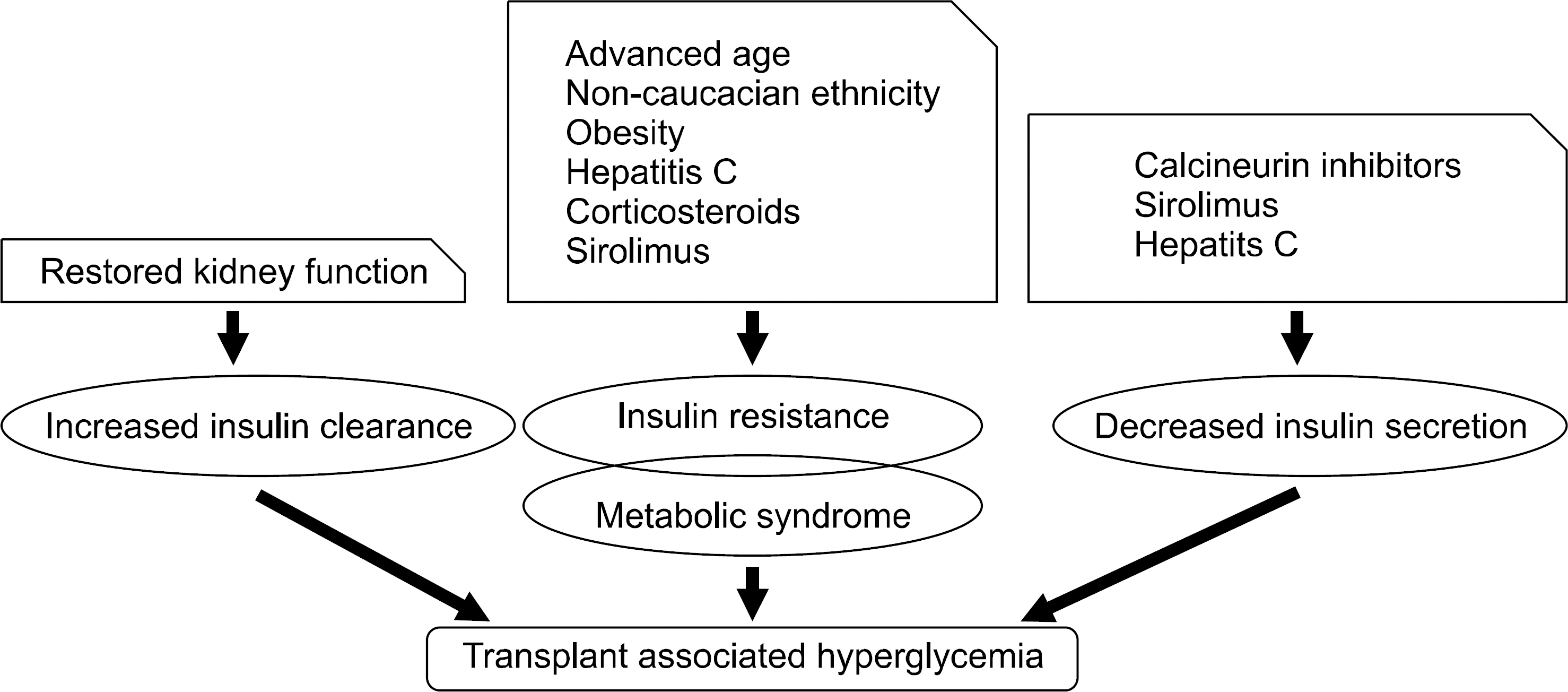Abstract
The new onset diabetes mellitus after transplantation is common and contributes to recipient morbidity and mortality. Here, we describe the prevalence, risk factors, pathogenesis, influence on outcomes, diagnosis, and treatment of posttransplant diabetes mellitus.
Go to : 
REFERENCES
1). Yoon KH, Lee JH, Kim JW, Cho JH, Choi YH, Ko SH, et al. Epidemic obesity and type 2 diabetes in Asia. Lancet. 2006; 368:1681–8.

2). International Diabetes Federation: Diabetes Atlas. 2nd ed.Belgium: International Diabetes Federation;2003. p. 17–71.
3). Kim DJ, Kim JY, Kim HY, Min KW, Park SW, Park IB, et al. Current status of diabetic end-stage renal disease using Korean Health Insurance Database. J Korean Diabetes Assoc. 2006; 30:355–62.

4). Ahn HY, Cho YM, Yi NJ, Suh KS, Lee KU, Park KS, et al. Predictive factors associated with the reversibility of posttransplantation diabetes mellitus following liver transplantation. J Korean Med Sci. 2009; 24:567–70.

5). Bodziak KA, Hricik DE. New-onset diabetes mellitus after solid organ transplantation. Transpl Int. 2009; 22:519–30.

6). Crutchlow MF, Bloom RD. Transplant-associated hyper-glycemia: a new look at an old problem. Clin J Am Soc Nephrol. 2007; 2:343–55.

7). Montori VM, Basu A, Erwin PJ, Velosa JA, Gabriel SE, Kudva YC. Posttransplantation diabetes: a systematic review of the literature. Diabetes Care. 2002; 25:583–92.
8). Kasiske BL, Snyder JJ, Gilbertson D, Matas AJ. Diabetes Mellitus after kidney transplantation in the United States. Am J Transplant. 2003; 3:178–85.

9). Woodward RS, Schnitzler MA, Baty J, Lowell JA, Lopez-Rocafort L, Haider S, et al. Incidence and cost of new onset diabetes mellitus among U.S. wait-listed and transplanted renal allograft recipients. Am J Transplant. 2003; 3:590–8.

10). Hur KY, Kim MS, Kim YS, Kang ES, Nam JH, Kim SH, et al. Risk factors associated with the onset and progression of posttransplantation diabetes in renal allograft recipients. Diabetes Care. 2007; 30:609–15.

11). Expert Committee on the Diagnosis and Classification of Diabetes Mellitus. Report of the expert committee on the diagnosis and classification of diabetes mellitus. Diabetes Care. 2003; 26(S1):S5–20.
12). Cosio FG, Pesavento TE, Kim S, Osei K, Henry M, Ferqusin RM. Patient survival after renal transplantation: IV. Impact of posttransplant diabetes. Kidney Int. 2002; 62:1440–6.

13). Sumrani N, Delaney V, Ding Z, Davis R, Daskalakis P, Friedman EA, et al. Posttransplant diabetes mellitus in cy-closporine-treated renal transplant recipients. Transplant Proc. 1991; 23:1249–50.
14). Fabrizi F, Martin P, Dixit V, Bunnapradist S, Kanwal F, Dulai G. Posttransplant diabetes mellitus and HCV se-ropositive status after renal transplantation: meta-analysis of clinical studies. Am J Transplant. 2005; 5:2433–40.

15). Ma Y, Yan WW. Chronic hepatitis C virus infection and post-liver transplantation diabetes mellitus. World J Gastroenterol. 2005; 11:6085–9.

16). Hirsch IB, Paauw DS. Diabetes management in special situations. Endocrinol Metab Clin North Am. 1997; 26:631–45.

17). Augustine JJ, Hricik DE. Steroid sparing in kidney transplantation: changing paradigms, improving outcomes, and remaining questions. Clin J Am Soc Nephrol. 2006; 1:1080–9.

18). Heit JJ, Apelqvist AA, Gu X, Winslow MM, Neilson JR, Crabtree GR, et al. Calcineurin/NFAT signalling regu-lates pancreatic beta-cell growth and function. Nature. 2006; 443:345–9.
19). Ekberg H, Tedesco-Silva H, Demirbas A, Vítko S, Nashan B, Gürkan A, et al. Reduced exposure to calcineurin inhibitors in renal transplantation. N Engl J Med. 2007; 357:2562–75.

20). Romagnoli J, Citterio F, Nanni G, Favi E, Tondolo V, Spagnoletti G, et al. Incidence of posttransplant diabetes mellitus in kidney transplant recipients immunosuppressed with sirolimus in combination with cyclosporine. Transplant Proc. 2006; 38:1034–6.

21). Snyder RW, Berns JS. Use of insulin and oral hypo-glycemic medications in patients with diabetes mellitus and advanced kidney disease. Semin Dial. 2004; 17:365–70.
22). Boudreaux JP, McHugh L, Canafax DM, Ascher N, Sutherland DE, Payne W, et al. The impact of cyclosporine and combination immunosuppression on incidence of posttransplant diabetes in renal allograft recipients. Transplantation. 1987; 44:376–81.
23). Jindal RM, Hjelmesaeth J. Impact and management of posttransplant diabetes mellitus. Transplantation. 2000; 70(11S):58–63.
24). Ducloux D, Kazory A, Chalopin JM. Posttransplant diabetes mellitus and atherosclerotic events in renal transplant recipients: a prospective study. Transplantation. 2005; 9:438–43.

25). Lentine KL, Brennan DC, Schnitzler MA. Incidence and predictors of myocardial infarction after kidney transplantation. J Am Soc Nephrol. 2005; 16:496–506.

26). Miles AM, Sumrani N, Horowitz R, Homel P, Maursky V, Markell MS, et al. Diabetes mellitus after renal transplantation: as deleterious as non-transplant-associated diabetes? Transplantation. 1998; 65:380–4.
27). Wilkinson A, Davidson J, Dotta F, Home PD, Keown P, Kiberd B, et al. Guidelines for the treatment and management of new-onset diabetes after transplantation. Clin Transplant. 2005; 19:291–8.
28). Kamar N, Toupance O, Buchler M, Sandres-Saune K, Izopet J, Durand D, et al. Evidence that clearance of hepatitis C virus RNA after alpha-interferon therapy in dial-ysis patients is sustained after renal transplantation. J Am Soc Nephrol. 2003; 14:2092–8.
29). Cosio FG, Kudva Y, van der Velde M, Larson TS, Textor SC, Griffin MD, et al. New onset hyperglycemia and diabetes are associated with increased cardiovascular risk after kidney transplantation. Kidney Int. 2005; 67:2415–21.

30). American Diabetes Association. Standards of medical care in diabetes-2008. Diabetes Care. 2008; 31(S1):S12–54.
Go to : 
 | Fig. 1.Pathogenic mechanisms leading to transplant associated hyperglycemia in kidney transplant recipients. Adapted from reference (8). |
Table 1.
WHO and American Diabetes Association (ADA) criteria for diagnosis of diabetes mellitus, impaired fasting glucose, and impaired glucose tolerance




 PDF
PDF ePub
ePub Citation
Citation Print
Print


 XML Download
XML Download